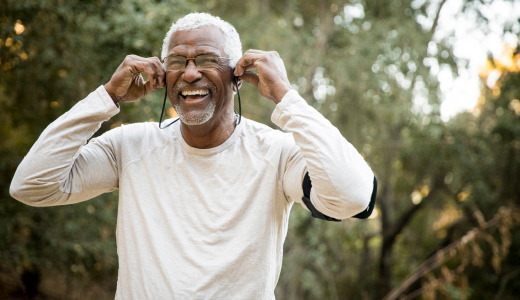Bupa's microsuction earwax removal service is a safe and effective way to remove excessive earwax
Our Health Advisers are trained and accredited in ear cleaning, using a method called microsuction, which uses a specialist suction device and camera that looks inside the ear.
Why choose microsuction earwax removal with Bupa?
Our service is only £60 for both ears with no hidden surprises. And if there’s no wax, you won’t get charged.
It’s easy to book online or by phone.
If there is any reason the procedure can't go ahead and you need further investigation the Health Adviser can refer you to a Bupa GP† or provide information to your NHS GP.
† This will incur an additional charge.
Microsuction is a safe, quick and effective way of earwax removal.
Plus, you don’t even need to be an existing Bupa customer to book an earwax removal appointment with us.‡

What is earwax?
Naturally produced in the ear canal, earwax moisturises and protects them from dust, germs, irritation and even insects. Most people don’t need to remove it because our ears are ‘self cleaning’ - earwax moves from part way down the canal to the outside of your ear naturally.
Some people can have problems with excess earwax, or it may get stuck in their ears. In these cases, people can suffer from discomfort or reduced hearing and can benefit from having the earwax removed. Bupa’s earwax removal service is a safe, effective way of sorting these issues.

What is ear microsuction?
Microsuction is one of the best ways to remove earwax. Once our trained advisers have assessed your ear canal, they’ll use a gentle suction device to remove any earwax blockages.
This suction device acts like a vacuum cleaner, helping to loosen and remove any impacted earwax. Once the procedure is over, we’ll use a microscope to check over your ears.
Previously, using an ear syringe with water was a common way to get rid of earwax, however microsuction is a quick and much safer method.
How does the Bupa earwax removal service work?
1. Book an appointment online or by phone
First things first, you’ll need an appointment and it’s easy to get one online. As part of the booking process, you’ll be asked some questions to make sure the service is the right option for you.
0333 242 9465 - We may record or monitor our phone calls. Lines are open Monday to Friday 8am to 6pm, Saturday 8am to 4pm, Bank holidays: 8am to 1pm.
2. Start using eardrops a few days before your appointment
Once booked, please start using ear drops to soften earwax and aid removal 3-4 times daily for 3-5 days initially. It is important that you head is horizontal and you massage the ear for 5 minutes to maximise the chance the wax softens and increase the chance of successful microsuction. Options include sodium bicarbonate 5% ear drops, olive or almond oil drops, and sodium chloride 0.9% nasal drops (off label use as ear drops). Please do not use any ear drops which contain hydrogen peroxide. As well as potentially causing irritation and discomfort during the procedure; these products can also cause microsuction to be unsuccessful.
Using ear drops before your appointment makes removal much easier and quicker. If our health adviser can’t remove all the wax, they’ll advise you on what to do next.
3. Go to your appointment at one of our Bupa health centres††
The appointment itself will last around 30 minutes. Our specially trained health advisers will run through some questions, talk you through the process and make sure you’re happy.
Our health adviser then uses a special camera to look inside your ear, before proceeding to remove any excess earwax. They’ll also take pictures, as this can be useful for comparisons in the future.
The sound of the earwax removal device can take a little getting used to if it’s your first time. Our health adviser will show you beforehand so you know what to expect. Having something in your ear can feel odd, but it shouldn’t hurt.
4. What happens next?
If the wax removal was unsuccessful, your health adviser will ask you to use olive oil drops for five days before re-booking a return appointment. There is a limit of one follow-up appointment. If wax removal is unsuccessful again then your health adviser will chat to you about what to do next.
If there’s no wax to remove you won’t be charged but our health adviser will talk with you about next steps. They may advise you to see a GP who could arrange treatment or refer you to a specialist. This may be if you have symptoms of excess earwax but no earwax to remove, so your ears can be checked for other causes.

How do I know if I need to remove earwax?
Our ears are self cleaning, so you shouldn’t need to remove earwax at all. For some people though, earwax can cause problems in one or both ears, such as:
- Muffled hearing
- Tinnitus (hearing added noises, like ruffling)
- Earache, itching or discomfort
It’s important to be sure that any symptoms you have are caused by earwax and not an infection or other problem, as this service is designed for those suffering with excessive earwax. People who commonly need ear wax removal are:
- Users of in ear headphones
- Users of hearing aids
- Regular cotton bud users
- People who use ear plugs regularly
If this is the first time you’re experiencing these symptoms, you have other symptoms or you’re just not sure, you should first see a GP to check you need this service.
Find your local Bupa health centre that offers earwax removal
Most people won’t need to remove wax, and some might be able to remove it themselves at home. But, there are options available from healthcare providers if your earwax is causing you trouble. Bupa currently offers earwax removal treatment at multiple locations. You can search for your nearest centre to see if it's available. In addition, employees for HSBC, GS and Citi can attend their on-site health centre.
You don’t need to have health insurance to book one of our earwax removal appointments.
While there are safe ways to remove earwax at home, like olive oil drops or ear canal hygiene sprays, these often aren't effective enough for people with excessive or impacted earwax. Our earwax removal service is one of the safest ways to get rid of excess wax. You’re seen by a trained professional who looks at your ears before and after the appointment, so you get the highest level of care possible.
In general, you should avoid putting anything in your ears, such as fingers or cotton buds. This can cause damage and risk infection. It also risks pushing wax further into your ear canal, making your ears feel more blocked, or even causing damage to your ear drum.
We use the safest method to remove earwax, which is microsuction. A microscopic camera helps us to look into your ear canal, so we can see and protect important structures like your ear drum while we safely remove your earwax. Then we use a gentle suction device to remove your earwax. We don’t use syringing to flush out earwax because this can cause infection and eardrum damage, and it isn't suitable for everyone.
To use Bupa’s earwax removal service, you must be over 18 and give your consent to the procedure, and you must understand the benefits and risks. The procedure isn’t suitable for anyone who won’t be able to sit still, as this poses a risk of damaging the ear.
Other things like ear infection within in less than 90 days, ear surgery, severe tinnitus or vertigo may mean that this service isn t suitable. You ll be able to see a full list of reasons which may make this service unsuitable for you when you make a booking, where you ll have the chance to complete a questionnaire. If this shows that the treatment isn t suitable, there s no need to proceed with the booking.
If anything changes between the time when you booked your earwax removal appointment and the time when you’re due to attend, please let us know because it could mean that the service is no longer suitable for you.
Earwax removal is likely to be more successful, and much more comfortable for you, if you use an over-the-counter earwax softener. Without doing this first, your earwax removal treatment could fail, especially if your earwax is hard and impacted. We advise that you use earwax softening drops for two to three days prior to your earwax removal treatment, or five days before if you think you have very hard earwax. Earwax softeners include olive oil drops or spray, or ear-canal hygiene sprays, and are available from your local pharmacist (who can advise if they are right for you)
- If you use a hearing aid, only use earwax softening drops at night and avoid wearing your hearing aid straight after putting drops or spray in, as this can damage your hearing aid.
- If you get a bad taste in your mouth after using the ear drops, this could mean that you have a hole in your ear drum. You might not know it’s there, and it's usually nothing to worry about. However, it would mean we can’t offer you our earwax removal service. You should stop using the ear drops and see your GP.
Side effects from microsuction are rare, but they include:
- Feeling dizzy or faint - This can be the body's response to the ear canal cooling down after having wax removed, and usually it’s just temporary. You shouldn't attend for earwax removal treatment if you're already experiencing dizzy or faint spells, and you should see a doctor about them.
- Damage to the ear/eardrum, which can cause slight bleeding - This is an unusual side effect, and being able to sit very still during the entire earwax removal procedure will significantly minimise the risk.
- Noise-induced damage - Again this is rare, but you might experience temporary hearing loss. This is because small muscles in your ear may contract to protect your ear against the noise of the suction device. It is extremely rare for tinnitus to be caused or worsened by microsuction.
- Infection - All of our tools are 'one per patient' and we follow strict infection control procedures. However, as with any procedure, earwax removal carries a very small risk of infection, for which treatments are available.
Terms and conditions
‡Our earwax removal service isn’t covered by Bupa health insurance. It’s an extra cost.
†† If you don’t come to your appointment, or you cancel it without giving us at least 24 hours’ notice, we will have to charge you a non-attendance fee.
Page last reviewed: 31 January 2025


